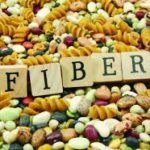
By Elliot Fisher
Fiber is an indigestible carbohydrate. There are two types of fiber: soluble and insoluble. Fiber can help reduce the risk of:
- Heart Disease1
- Stroke1
- Hypertension1
- Diabetes1
- Obesity1
- Some Gastrointestinal Disorders1
- Certain Cancers2,3
Cardiovascular Disease
Heart disease is the number one killer in the United States.4 Insoluble fiber helps lower low density lipoprotein (LDL) cholesterol in the body which is linked to atherosclerosis, or hardening of the arteries.1,5
Cancer
Cancer is the second cause of deaths in America.4 Fiber consumption can help prevent certain cancers. These include colon cancer and breast cancer. Fiber can decrease the risk of colon cancer by helping increase bowel transit time which may decrease the amount of time any harmful carcinogens may act in the colon. Fiber may reduce breast cancer by assisting in the lowering of total estrogen content, as high estrogen levels are associated with breast cancer.
Diabetes
Fiber can also help prevent diabetes by slowing down the absorption time of sugar from the digestive tract. This allows the body to have more stable blood glucose levels and less spikes after eating.
Obesity
Additionally, fiber can also help prevent you from gaining excess weight. When fiber is added to a meal, a lot of bulk is added the meal. This fills the digestive tract and makes you feel fuller longer. The increased sense of fullness can allow you to eat fewer calories total helping you prevent gaining extra weight.
How much fiber should you eat?
Research recommends individuals to eat about 14 grams of fiber per 1000 kcal they consume per day.6 So if you consume a 2000 kcal/day diet you should consume about 28 grams of fiber/day. Another blanket recommendation that has been proposed is for females to eat a minimum of 25 grams of fiber/day and for males to eat a minimum of 38 grams of fiber/day.7
It’s important to get enough fiber for health, however too much fiber can be harmful. Too much fiber can hinder the absorption nutrients.7 Because of this it is recommended not to eat more than 20% of your carbohydrates from fiber or around 55-60 grams of fiber/day.
Sources of Fiber
- Beans
- Black beans 16 grams of fiber/100 grams
- Pinto beans 16 grams of fiber/100 grams
- Lentils 8 grams of fiber/100 grams
- Wheat/Bran 15 grams of fiber/100 grams
- Oatmeal 9 grams of fiber/cup
- Avocado 7.5 grams of fiber/100 grams (about half of an average avocado)
- Berries
- Blueberries 3.5 grams of fiber/cup
- Blackberries 8 grams of fiber/cup
- Raspberries 8 grams of fiber/cup
- Nuts
- Almonds 3.5 grams of fiber/oz.
- Walnuts 2 grams of fiber/oz.
- Peanuts 2.5 grams of fiber/oz.
References
- Anderson, James W., et al. “Health benefits of dietary fiber.” Nutrition reviews 67.4 (2009): 188-205.
- Aune, Dagfinn, et al. “Dietary fiber and breast cancer risk: a systematic review and meta-analysis of prospective studies.” Annals of Oncology 23.6 (2012): 1394-1402.
- Murphy, Neil, et al. “Dietary fibre intake and risks of cancers of the colon and rectum in the European prospective investigation into cancer and nutrition (EPIC).” PloS one 7.6 (2012): e39361.
- Xu, Jiaquan, et al. “Deaths: final data for 2014.” (2016).
- Ference, Brian A., et al. “Low-density lipoproteins cause atherosclerotic cardiovascular disease. 1. Evidence from genetic, epidemiologic, and clinical studies. A consensus statement from the European Atherosclerosis Society Consensus Panel.” European heart journal (2017): ehx144.
- Slavin, Joanne L. “Position of the American Dietetic Association: health implications of dietary fiber.” Journal of the American Dietetic Association 108.10 (2008): 1716-1731.
- Shah, Meena, et al. “Effect of a high-fiber diet compared with a moderate-fiber diet on calcium and other mineral balances in subjects with type 2 diabetes.” Diabetes care 32.6 (2009): 990-995.
Comments are closed.